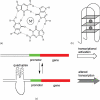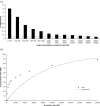G-quadruplexes in promoters throughout the human genome
- PMID: 17169996
- PMCID: PMC1802602
- DOI: 10.1093/nar/gkl1057
G-quadruplexes in promoters throughout the human genome
Erratum in
- Nucleic Acids Res. 2007;35(6):2105
Abstract
Certain G-rich DNA sequences readily form four-stranded structures called G-quadruplexes. These sequence motifs are located in telomeres as a repeated unit, and elsewhere in the genome, where their function is currently unknown. It has been proposed that G-quadruplexes may be directly involved in gene regulation at the level of transcription. In support of this hypothesis, we show that the promoter regions (1 kb upstream of the transcription start site TSS) of genes are significantly enriched in quadruplex motifs relative to the rest of the genome, with >40% of human gene promoters containing one or more quadruplex motif. Furthermore, these promoter quadruplexes strongly associate with nuclease hypersensitive sites identified throughout the genome via biochemical measurement. Regions of the human genome that are both nuclease hypersensitive and within promoters show a remarkable (230-fold) enrichment of quadruplex elements, compared to the rest of the genome. These quadruplex motifs identified in promoter regions also show an interesting structural bias towards more stable forms. These observations support the proposal that promoter G-quadruplexes are directly involved in the regulation of gene expression.
Figures




References
-
- Simonsson T. G-Quadruplex DNA structures—variations on a theme. Biol. Chem. 2001;382:621–628. - PubMed
-
- Sen D., Gilbert W. Formation of parallel four-stranded complexes by guanine-rich motifs in DNA and its implications for meiosis. Nature. 1988;334:364–366. - PubMed
-
- Blackburn E.H. Structure and function of telomeres. Nature. 1991;350:569–573. - PubMed

